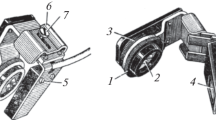Abstract
A cyberphysical system for multiparametric monitoring and analysis of patients with epilepsy needs the possibility to assess a variety of different sensor signals, transmit these signals into a central online system (electronic health record, database) and analyze the data to give a feedback to the patient or the clinician. The architecture of such a system is described in this chapter. Based on a description of the application the overall architecture and the different hardware and software modules of the systems with their interfaces are defined.
Access this chapter
Tax calculation will be finalised at checkout
Purchases are for personal use only
Similar content being viewed by others
References
Dai S, Zhang Y (2006) A wireless physiological multi-parameter monitoring system based on mobile communication networks. In: Proceedings of the 19th IEEE symposium on computer based medical systems based on mobile communication networks. IEEE Computer Society, Washington, DC, pp 473–478
Lorincz K, Chen B, Challen G, Chowdhury A, Patel S, Bonato P, Welsh M (2009) Mercury: a wearable sensor network platform for high-fidelity motion analysis. In: Proceedings of the 7th ACM conference on embedded networked sensor systems (SenSys’09), pp 1–14
Gouravajhala SR, Khuon L (2012) A multi-modality sensor platform approach to detect epileptic seizure activity. In: Proceedings of the 2012 38th annual Northeast bioengineering conference (NEBEC), pp 233–234
Alkan A, Sahin Y, Karlik B (2006) A novel mobile epilepsy warning system. In: AI 2006 advances in artificial intelligence, 2006
Poh M-Z, Loddenkemper T, Swenson NC, Goyal S, Madsen JR, Picard RW (2010) Continuous monitoring of electrodermal activity during epileptic seizures using a wearable sensor. In: Proceedings of the annual international conference of the IEEE Engineering in Medicine and Biology Society, 2010, pp 4415–4418
Hall J (2003) Brush up on Bluetooth. GSEC practical assignment version
Lee J, Kapitanova K, Son SH (2010) The price of security in wireless sensor networks. Comput Netw 54:2967–2978
Author information
Authors and Affiliations
Corresponding author
Editor information
Editors and Affiliations
Rights and permissions
Copyright information
© 2015 Springer International Publishing Switzerland
About this chapter
Cite this chapter
Hey, S. et al. (2015). System Architecture. In: Voros, N., Antonopoulos, C. (eds) Cyberphysical Systems for Epilepsy and Related Brain Disorders. Springer, Cham. https://doi.org/10.1007/978-3-319-20049-1_7
Download citation
DOI: https://doi.org/10.1007/978-3-319-20049-1_7
Publisher Name: Springer, Cham
Print ISBN: 978-3-319-20048-4
Online ISBN: 978-3-319-20049-1
eBook Packages: EngineeringEngineering (R0)




